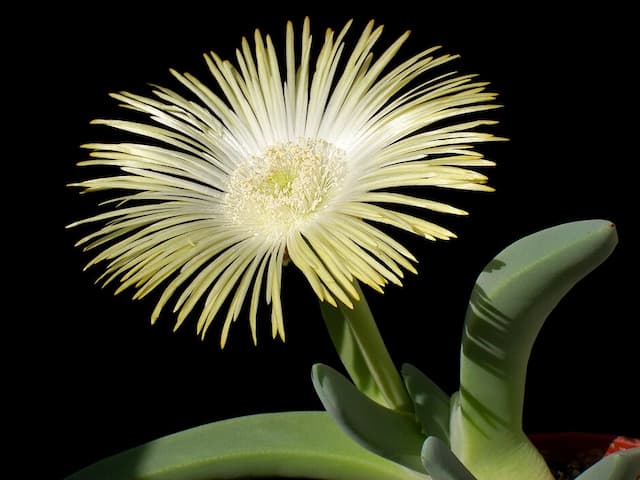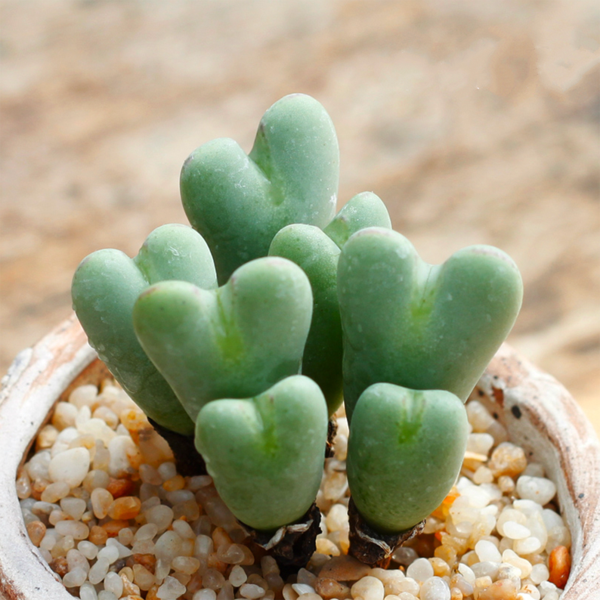Dollar Plant Rhombophyllum rhomboideum

ABOUT
Commonly known as the dollar plant, Rhombophyllum rhomboideum boasts thick, fleshy leaves that showcase a remarkable geometry, closely resembling the shape of rhomboids with rounded corners and edges. These leaves are tightly packed together in a rosette, giving the plant a compact and structured appearance. The foliage typically exhibits a deep green hue, which can sometimes be accentuated further by an attractive reddish tint along the margins or when the plant undergoes stress, such as from exposure to strong sunlight or low water availability. During the flowering season, the dollar plant produces small, vibrant yellow flowers that emerge from the center of the rosettes, catching the eye among its succulent green leaves. These blooms add a cheerful splash of color to its overall aesthetic. The dollar plant's distinctive look, with its neatly arranged leaves and sunny flowers, makes it a visually appealing choice for rock gardens, succulent collections, or as a groundcover in dry, arid landscapes. Overall, the plant emanates a robust and resilient character, typical of many other succulent species adapted to water-wise environments.
About this plant
 Names
NamesFamily
Aizoaceae.
Synonyms
Doll's Houseplant, Baby Sun Rose.
Common names
Rhombophyllum rhomboideum
 Toxicity
ToxicityTo humans
The Rhombophyllum rhomboideum, commonly known as Dewplant, is not widely recognized as a toxic plant to humans. There is limited information available on its toxicity profile and no significant reports of poisoning. However, as with any plant, individual sensitivities can vary. If ingested, it is always best to err on the side of caution and consult a medical professional, albeit no specific symptoms of poisoning from ingesting this particular plant are well documented or widely recognized.
To pets
The Dewplant, known scientifically as Rhombophyllum rhomboideum, is not commonly regarded as a toxic plant to pets such as cats and dogs. There is a scarcity of information about its toxicity to animals, and it is not typically listed as a plant of concern for pet owners. However, ingestion of plants can sometimes lead to gastrointestinal upset in pets, so if any animal ingests this plant, monitoring for signs of distress and contacting a veterinarian would be advisable. Specific symptoms of poisoning by this plant in pets are not commonly reported or well characterized.
 Characteristics
CharacteristicsLife cycle
Perennials
Foliage type
Evergreen
Color of leaves
Green
Flower color
Yellow
Height
6 inches (15 cm)
Spread
12 inches (30 cm)
Plant type
Succulent
Hardiness zones
10
Native area
South Africa
Benefits
 General Benefits
General Benefits- Drought tolerance: Rhombophyllum rhomboideum, also known as the dewplant, is highly resilient to drought conditions due to its succulent nature, making it an ideal plant for water-efficient gardens.
- Easy maintenance: The dewplant requires minimal care, making it suitable for gardeners of all skill levels, including beginners.
- Ground cover: With its spreading habit, the dewplant provides effective ground cover that can reduce soil erosion and suppress weeds.
- Attractive flowers: It produces small, yellow, star-shaped flowers that can add a decorative touch to gardens and landscapes.
- Rock gardens: Due to its compact size and tolerance of poor soils, the dewplant is well-suited for rock gardens and similar environments.
- Containers and borders: The dewplant can be grown in containers or used as a border plant, providing versatility in garden design.
- Wildlife friendly: The flowers of the dewplant attract pollinators such as bees, contributing to the biodiversity of the garden ecosystem.
 Medical Properties
Medical PropertiesThis plant is not used for medical purposes.
 Air-purifying Qualities
Air-purifying QualitiesThis plant is not specifically known for air purifying qualities.
 Other Uses
Other Uses- Artistic Display: Rhombophyllum rhomboideum, commonly known as Dewplant, can be utilized in succulent art creations due to its geometric leaf pattern, offering an appealing aesthetic for gardens or art installations.
- Education: The Dewplant can serve as an educational tool in botany classes to demonstrate how succulents store water in arid climates and the diverse survival adaptations of plants.
- Mindfulness and Relaxation: Keeping a Dewplant in the workspace or home may contribute to creating a calming environment, which can be beneficial for mindfulness practices and stress reduction.
- Photography: With its unique shape and attractive blooms, the Dewplant can become a subject of interest for photographers, especially those specializing in botanical or nature photography.
- Landscape Design: Used as ground cover or part of a rock garden, the Dewplant can add texture and color contrast to landscape designs.
- Culinary Decoration: Although not edible, the Dewplant can be used as a non-toxic garnish for plating in culinary presentations, adding a touch of greenery.
- Thematic Gardens: The Dewplant can be incorporated into theme-based gardens, such as fairy or miniature gardens, due to its small size and interesting leaf shape.
- Wedding Decor: Dewplant's attractive foliage and flowers can be used in wedding bouquets or table arrangements as a symbol of resilience and enduring love.
- Recycled Container Gardening: Dewplant is well-suited for growing in recycled containers, promoting sustainability by repurposing household items as plant pots.
- Heat Absorption: Planted in urban spaces, the Dewplant can help in absorbing excess heat due to its succulent nature, potentially contributing to the reduction of urban heat islands.
Interesting Facts
 Feng Shui
Feng ShuiThe Dwarf Cobweb Hen and Chicks is not used in Feng Shui practice.
 Zodiac Sign Compitability
Zodiac Sign CompitabilityThe Dwarf Cobweb Hen and Chicks is not used in astrology practice.
 Plant Symbolism
Plant SymbolismUnfortunately, there is no widely recognized symbolism or list of symbolic meanings attributed to Rhombophyllum rhomboideum, which is commonly referred to as "dewplant". This plant is not typically featured in symbolic or cultural contexts like more widely known plants such as roses or lilies. Therefore, I cannot provide an HTML list of symbolic meanings for the dewplant, as it does not have established symbolic connotations.
 Water
WaterThe Rhombophyllum rhomboideum, commonly known as the Dewplant, requires moderate watering. It is best to water when the top inch of soil feels dry to the touch, which typically means watering approximately once every 7 to 10 days depending on the environmental conditions. When watering, thoroughly saturate the soil until water begins to drain from the bottom of the pot, indicating the roots have received enough moisture. In total, you might use around 8 to 16 ounces of water each time for a small to medium-sized pot. During winter, reduce the frequency as the plant goes into dormancy.
 Light
LightDewplant thrives in bright, indirect sunlight. The ideal spot for a Dewplant would be in a location where it can receive plenty of light without being in the direct path of harsh midday sun, like a well-lit room or near a south-facing window with sheer curtains to diffuse the light.
 Temperature
TemperatureThe Dewplant prefers a temperature range between 50 to 80 degrees Fahrenheit. It can withstand temperatures as low as 30 degrees Fahrenheit but should not be exposed to frost. The ideal temperature for healthy growth is between 65 and 75 degrees Fahrenheit.
 Pruning
PruningPruning the Dewplant is essential to encourage bushier growth and remove any dead or yellowing leaves. Pruning is best done in the spring or early summer, before the plant enters its active growing phase. It's typically not necessary to prune more than once a year, unless you're shaping the plant or removing damaged foliage.
 Cleaning
CleaningAs needed
 Soil
SoilDewplant (Rhombophyllum rhomboideum) thrives in well-draining, sandy or gritty soil. A mix of cactus potting soil with extra perlite or coarse sand added is ideal. This plant prefers a slightly acidic to neutral pH range (around 6.0 to 7.0). A top dressing of gravel can help replicate its natural rocky habitat.
 Repotting
RepottingDewplant does not have a fast growth rate and therefore only needs repotting every two to three years. Repot during spring or early summer when the plant has outgrown its current pot or the soil has degraded.
 Humidity & Misting
Humidity & MistingDewplant prefers low to moderate humidity levels. As a succulent, it is well adapted to drier conditions and does not require high humidity; ensuring good air circulation is more critical for its well-being.
 Suitable locations
Suitable locationsIndoor
Ensure bright light and good ventilation for healthy indoor growth.
Outdoor
Plant in full sun to partial shade, in well-draining soil.
Hardiness zone
9-11 USDA
 Life cycle
Life cycleRhombophyllum rhomboideum, commonly known as the "Dewplant," begins its life cycle as a seed, which germinates in warm, moist soil in spring. After germination, it develops a succulent rosette of fleshy, triangular leaves, enabling it to thrive in dry conditions by storing water. As it matures, the Dewplant spreads outwards through offsets to form a dense, ground-covering mat. Throughout the summer, it produces small, yellow flowers that open during the day and attract pollinators, leading to the pollination and subsequent seed formation. Once seeds are developed, they are dispersed, often by wind or through contact with animals, to initiate a new cycle of growth. The plant may go dormant in winter, reducing growth and conserving energy, but it is a perennial and will resume active growth with the return of favorable conditions in spring.
 Propogation
PropogationPropogation time
Spring to Summer
Propogation: Rhombophyllum rhomboideum, commonly known as the Dewplant, is a succulent that can be easily propagated through leaf cuttings. The best time to propagate Dewplants is during its active growth period, which typically falls in the spring or early summer. To propagate by leaf cuttings, a healthy leaf is chosen and gently twisted off the plant. The base of the leaf where it was attached should be allowed to callous over for a few days to prevent rot when planted. The leaf can then be placed on well-draining soil, and in a few weeks, new roots should begin to emerge. Caring for the cuttings involves keeping the soil lightly moist but not waterlogged and providing bright, indirect light. This simple method leverages the plant's natural ability to regenerate from just a small piece of itself.


![Ice plant [Red Mountain]](/_next/image?url=https%3A%2F%2Fplants-admin.emdemapps.com%2Fimages%2Fplants%2F%2Fimages%2F604b565275469.png&w=640&q=75)






